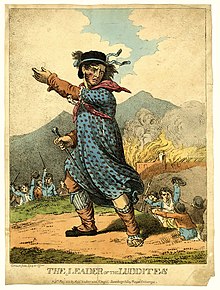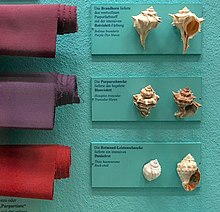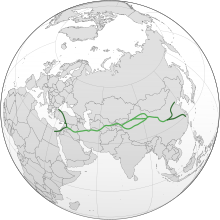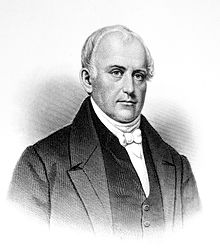Portal:Clothing
The Clothing Portal

Clothing (also known as clothes, garments, dress, apparel, or attire) is any item worn on the body. Typically, clothing is made of fabrics or textiles, but over time it has included garments made from animal skin and other thin sheets of materials and natural products found in the environment, put together. The wearing of clothing is mostly restricted to human beings and is a feature of all human societies. The amount and type of clothing worn depends on gender, body type, social factors, and geographic considerations. Garments cover the body, footwear covers the feet, gloves cover the hands, while hats and headgear cover the head, and underwear covers the private parts.
Clothing has significant social factors as well. Wearing clothes is a variable social norm. It may connote modesty. Being deprived of clothing in front of others may be embarrassing. In many parts of the world, not wearing clothes in public so that genitals, breast, or buttocks are visible could be considered indecent exposure. Pubic area or genital coverage is the most frequently encountered minimum found cross-culturally and regardless of climate, implying social convention as the basis of customs. Clothing also may be used to communicate social status, wealth, group identity, and individualism. (Full article...)
Textile is an umbrella term that includes various fiber-based materials, including fibers, yarns, filaments, threads, different fabric types, etc. At first, the word "textiles" only referred to woven fabrics. However, weaving is not the only manufacturing method, and many other methods were later developed to form textile structures based on their intended use. Knitting and non-woven are other popular types of fabric manufacturing. In the contemporary world, textiles satisfy the material needs for versatile applications, from simple daily clothing to bulletproof jackets, spacesuits, and doctor's gowns. (Full article...)
Textile arts are arts and crafts that use plant, animal, or synthetic fibers to construct practical or decorative objects. (Full article...)
Selected articles -
Did you know (auto generated)

- ... that during the Second World War, the British government's campaign Make-Do and Mend encouraged the public to fashion men's clothes into womenswear?
- ... that Church Clothes 4 deals with Christian hip hop artist Lecrae's faith deconstruction and reconstruction?
- ... that during a renovation of 4 Park Avenue, workers found a sealed room with women's clothes and shoes that was not in the building's blueprints?
- ... that Liberian paramount chief Tamba Taylor worked as a tailor and claimed to have sewn clothes for Ethiopian emperor Haile Selassie and Ghanaian president Kwame Nkrumah?
- ... that after being criticized for dressing "like a doll" at an important meeting, pioneering Russian feminist Anna Filosofova replied that "clothes do not make the woman"?
- ... that pioneering Daily News camerawoman Evelyn Straus had her clothes custom-made to carry her film and flashbulbs?
More Did you know
- ... that grosgrain ribbons or textiles finished by calendering become the thin, glossy and papery fabric known as moire (pictured)?
- ... that shed is a weaving term for the temporary separation in warp threads so the shuttle with the weft can go through?
- ...that a selvage is the edge of a piece of woven or knitted fabric that won't fray or come unraveled?
Related portals
Selected image

Blackwork Embroidery is a form of counted-thread embroidery that is usually stitched on even-weave fabric. Any black thread can be used, but firmly twisted threads give a better look than embroidery floss. Traditionally blackwork is stitched in silk thread on white or off-white linen or cotton fabric. Blackwork was the most common English domestic embroidery technique during the reign of Elizabeth I.
General images -
Selected quote
Main topics
Recognized content
Extended content
| ||
|---|---|---|
Featured articlesGood articlesFeatured pictures
Featured portals
|
Subcategories
WikiProjects
- Parent project
- Main project
- Participants
- Related projects
WikiProject Fashion • WikiProject Knots • WikiProject Sculpture • WikiProject Visual arts
What are WikiProjects?
Things you can do
Associated Wikimedia
The following Wikimedia Foundation sister projects provide more on this subject:
-
Commons
Free media repository -
Wikibooks
Free textbooks and manuals -
Wikidata
Free knowledge base -
Wikinews
Free-content news -
Wikiquote
Collection of quotations -
Wikisource
Free-content library -
Wikiversity
Free learning tools -
Wiktionary
Dictionary and thesaurus







































































